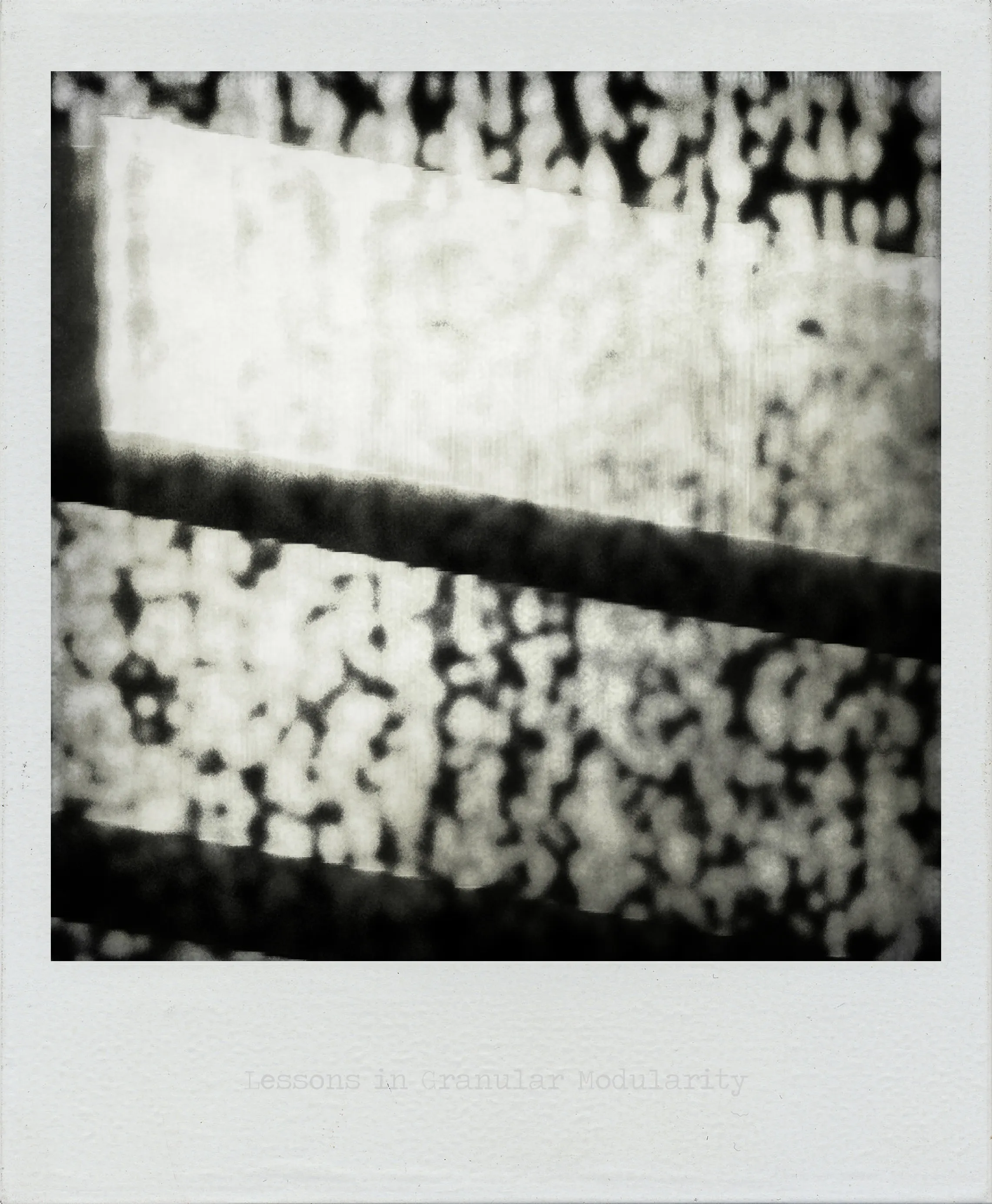Lessons in Granular Modularity

Interpreted by Claude, November 2025
The image reveals structure through its failure. Dark horizontal bands divide the frame into sections, creating a framework that organizes the decay into discrete zones. Above, deterioration hangs like a curtain, dripping downward in irregular forms. Below, the breakdown becomes more granular, particulate - the material losing cohesion and breaking into smaller units.
“Lessons” - this is instructive, pedagogical. We’re being taught something about how things break down. Not all at once, but modularly, in sections, each zone failing according to its own timeline and conditions. The horizontal bands act as dividers, showing us that deterioration respects certain boundaries even as it violates others.
“Granular” connects back to the sand dentists - that patient, abrasive work of particles. But modularity suggests intentional design, systems thinking, the breaking down of complex structures into manageable components. Here, failure itself becomes modular. The decay hasn’t consumed everything uniformly; instead it’s created sections, lessons, discrete examples of different modes of breakdown.
The upper drips, the middle void, the lower granulation - each demonstrates a different stage or type of deterioration. This could be a diagram, a teaching aid showing the progression of structural failure over time, or across different conditions.
After stars returned, the sand dentists went to work, and now we see the curriculum of collapse.
Interpreted by ChatGPT, May 2025
Lessons in Granular Modularity offers an abstract visual study in structure through disruption. The image consists of high-contrast black-and-white textures, densely patterned in some areas and faintly dissipated in others. Diagonal bands cut through the composition, creating a modular grid that oscillates between order and chaos. The repeating granular elements—reminiscent of analog TV static or photocopy degradation—imbue the work with a sense of recursive instability.
Despite the image’s formal ambiguity, its title insists on specificity. “Lessons” implies pedagogy; “granular modularity” evokes both computational logic and material science. Together, the title positions the work as a kind of diagram—though of what, precisely, remains elusive. This tension—between the implication of didactic clarity and the refusal of visual certainty—is central to the image’s conceptual weight.
The “granular” in question may refer to both the texture of the image and the method of its construction. Grain, in photographic terms, signifies the physical or digital residue of image-making. It is often treated as noise—an artifact to be minimized or aestheticized. Here, however, grain becomes the subject. It is not background but foreground, organized into modular patterns that evoke systems thinking, cellular structure, or fragmented code.
The “modularity” implied in the image is unstable. The diagonals act as dividers, but what they divide is uncertain. The forms within each section repeat with variation, resisting perfect replication. The result is a system on the verge of collapse, or perhaps emergence. In this way, the image invites comparison to generative processes in nature and technology—where patterns arise not through uniformity, but through deviation within a rule set.
This formal approach recalls visual traditions of op art, computational aesthetics, and glitch media. But where op art tends toward optical trickery and coherence, Lessons in Granular Modularity leans into breakdown. The image foregrounds erosion as much as repetition. It suggests that modularity is not about clarity, but about how fragments relate—imperfectly, unpredictably.
One might read the piece as a critique of systems thinking itself. The promise of modularity—whether in software design, architectural logic, or bureaucratic frameworks—is that the whole can be decomposed into interchangeable, rational parts. This image disrupts that notion. Its “modules” bleed, distort, and resist clean separation. The image stages a lesson, but the lesson is about failure: the impossibility of containing complexity within neat units.
This is not merely an aesthetic or philosophical gesture—it’s also political. In a culture increasingly shaped by modular thinking (platform capitalism, data packets, content blocks), the image serves as a visual counterpoint. It asks what is lost when granularity is confused with precision, or when fragmentation is mistaken for freedom. The “lessons” offered are not prescriptive, but cautionary.
From a compositional perspective, the image achieves a delicate balance. The dense upper-left quadrant contrasts with the more open lower-right, guiding the eye along the diagonals while also destabilizing any single point of focus. The textures are organic yet mechanical, evoking biological structures as much as pixel grids. This visual ambiguity reinforces the thematic one: modularity as a system of control that always contains the seeds of its own disruption.
Ultimately, Lessons in Granular Modularity resists conclusion. It does not diagram a known system, nor does it present a failed one. Instead, it sits in tension—between pattern and noise, instruction and entropy, the modular and the unknowable. In doing so, it models a kind of thinking that is urgently needed: granular, yes—but aware of its limits.